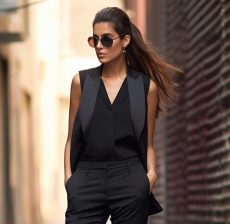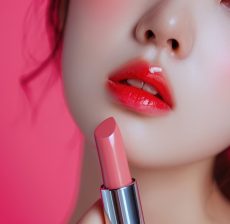
1. Understand the different sorts of modelling.
2. Pick an industry niche that suits you.
3. Practice your poses and learn to work the look.
4. Work through connections you already have to secure portfolio building work.
5. Keep building your experience in front of the camera through collaborations.
6. Gather your best shots and create a portfolio.
7. Design a model comp card, website and build a social media following.
8. Research modelling agents and potential clients looking for your aesthetic.
9. Network with models, photographers, brand managers and agents.
10. Get tough and learn to shrug off rejections.
11. Develop your personal brand and keep honing your skills.
12. Don’t give up – remain persistent, patient and keep working at it.
No one has experience when they first start. However, by staying committed, you can break into modelling even with little or no experience.

If you’re certain modelling is for you, you have to pick a path to take.
Today, there’s a myriad of ways to embark upon a career as a model. You should choose a niche that suits your look, shape, size and personality. Here are some options:
- Commercial Models help sell products/services through promotional campaigns.
- Fashion Models usually star in photoshoots for fashion brands and magazines.
- Runway Models walk the catwalk on behalf of fashion designers.
- Catalogue Models show off a brand’s clothes/accessories in catalogue work.
- Parts Models promote goods using certain body parts, e.g. hands, feet, hair, etc.
- Fits Models help clothing companies improve the fit of their garments.
- Promotional Models often work at trade shows and events to represent a brand.
- Plus-size Models focus on projects that require individuals size 12 or above.
- Petite Models focus on projects that require a shorter or smaller frame size.
- Fitness Models focus on projects with an emphasis on healthy, toned physiques.
- Mature Models focus on projects that requires individuals age 50 or above.
- Lingerie and Swimwear Models help sell underwear, swimsuits and night attire.
- Maternity Models help promote parenting, motherhood and baby brands.
- Child Models promote toys, kid’s clothing, schools or other youngster brands.
- Art Models present themselves to artists to sculpt, paint or draw.
- Stock Photography Models work with photographers to create stock images.

Like most professions, there are certain qualities you need for this role.
A good model is able to:
- communicate and work well with other people.
- listen, take direction and follow instructions.
- remain flexible, adaptable and open to change.
- carry themselves with poise, dexterity, confidence and grace.
- maintain physical health, fitness and endurance as days can be long.
- keep patient and calm even during stressful periods.
- manage workloads, practice good time management and stay organised.
- remain focused, committed and positive at all times.

The simple answer is it depends on the type of modelling you’re looking to pursue.
In theory, there aren’t any set height or weight requirements. Having said that, certain projects or sectors of the industry may request particular specifications. For instance, some agencies or runway shows might only accept models over a certain height.
In contrast, there are niches in the modelling world where being tall and skinny isn’t the be all and end all. Body physique and criteria varies depending on the job. What may matter more to a client is a model with a look that fits their brand identity and product.
If there is a positive it’s that the modelling industry, in recent times, has become far more inclusive and accepting of models of all races, ethnicities, sizes, ages and shapes. It means models from all walks of life are today gracing catwalks and promo campaigns.

Where do we start!
First up, a common misconception is that modelling is glamourous. This couldn’t be further from the truth. Most successful models will tell you that it takes perseverance, dedication, a good attitude and hard graft.
A second misconception is you must not only have a perfect body and flawless skin, but also be tall and thin. In fairness, the industry is now much more diverse. There are many different career paths and genres of modelling. You just have to find the right fit.

Enrolling in a modelling school is not a must to enter the profession. In fact, many models have broken into the industry without attending any formal school or class.
It’s down to personal choice but if you’re someone who prefers more guidance and has the time and money, a modelling school can help to prepare you for what the career entails, e.g. how to pose, walk a runway, build self-esteem, book jobs, etc. Some schools might even have connections within the industry that can help you get started.
Like with anything, it’s important to do your research to find a school that’s both reputable and accredited. Plus, don’t be afraid to ask questions and seek recommendations from other models and professionals.

Don’t take it personally. The reality is rejection is part and parcel of the job.
Modelling calls for a thick skin to handle criticism. And let’s face it, you’re not going to meet every brand’s criteria and style.
Disappointment is inevitable in the industry. Given this, it’s best to shrug off rejections, remain gracious, stay positive and move on.

As a model, you have the choice to either work freelance or sign with a modelling agency whose role will be to help you find jobs.
If you decide on the latter, a good first step it to go online and look for agencies that specialise in the kind of modelling you plan to pursue. e.g. fashion, plus-size, etc.
Next up is to do some due diligence to check that any agency you’re considering is legitimate and reputable. Vetting will help you to distinguish credible modelling agencies from non-legitimate outfits.
To determine if an agency is trustworthy, it’s a good idea to:
- Dig into their history, background, reputation and track record.
- Research their specialities and the types of models they represent.
- Check their client list, testimonials and success stories.
- Look at their website, social media presence and online reviews.
- Review their industry connections and the reach of their network.
- Familiarise yourself with their agreements, contract terms and fee structure.
Trust your instincts. From any dealings with an agency, what impression do you have of their professionalism?
Reach out to other models they represent. Canvass their feedback, thoughts and opinions. What sort of work do they usually secure for their models? How does the agency treat them?
To follow are red flags to watch out for:
- a bad reputation
- poor reviews
- excessive upfront fees
- high portfolio design charges
- exorbitant model training costs
- lack of transparency when it comes to contract details
- reluctance to share fees and commission rates
- pressure to sign contracts quickly
- unprofessional conduct, e.g. being pushy, disrespectful, unethical, etc.
Be wary of any guaranteed work promises that sound too good to be true.
Thoroughly review any contract before you sign. Make sure you understand all clauses. Take note of the agreement length, exclusivity conditions, commission rates and any expenses for which you’re liable.
If something is unclear, request clarification or seek legal advice. It’s essential to understand what you’re getting into in order to prevent future disagreements and misunderstandings.

Are you looking for a ‘model’ life?
If so, Hitting the Catwalk is a campaign designed to provide models in the making with the knowledge, know-how and support to break into the profession and develop a highly successful career.

Help is at hand!
Here’s some places and spaces to find more support and information.
You might also like our ‘Hit Lists.‘ They’re compilations of our favourite resources for aspiring models from books and masterclasses to online tools, skincare tips, gifts and much more.

